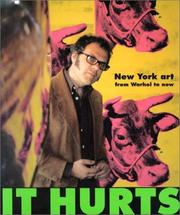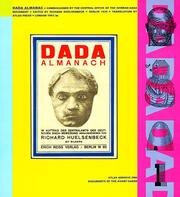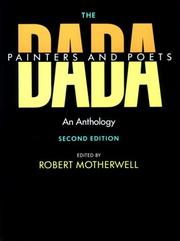| Listing 1 - 10 of 206 | << page >> |
Sort by
|
Periodical
Abstract | Keywords | Export | Availability | Bookmark
 Loading...
Loading...Choose an application
- Reference Manager
- EndNote
- RefWorks (Direct export to RefWorks)

ISBN: 1901785033 Year: 1998 Publisher: London : 21 Publishing,
Abstract | Keywords | Export | Availability | Bookmark
 Loading...
Loading...Choose an application
- Reference Manager
- EndNote
- RefWorks (Direct export to RefWorks)
MODERN ARTS --- WARHOL (ANDY) --- 20th CENTURY --- MODERN ARTS --- WARHOL (ANDY) --- 20th CENTURY
Book
ISBN: 0435180258 Year: 1975 Publisher: London Heinemann
Abstract | Keywords | Export | Availability | Bookmark
 Loading...
Loading...Choose an application
- Reference Manager
- EndNote
- RefWorks (Direct export to RefWorks)
Sociology of culture --- Arts, Modern --- -Modern arts --- -Arts, Modern
Book
ISBN: 0262318326 1306118247 9781306118248 9780262318327 9780262019422 0262019426 0262318334 Year: 2013 Publisher: Cambridge, Massachusetts : MIT Press,
Abstract | Keywords | Export | Availability | Bookmark
 Loading...
Loading...Choose an application
- Reference Manager
- EndNote
- RefWorks (Direct export to RefWorks)
Arts, Modern. --- New media art --- Arts, Modern --- Modern arts --- Historiography.
Book
ISBN: 9783990435168 3990435167 9783990435151 Year: 2013 Publisher: Vienna, Austria
Abstract | Keywords | Export | Availability | Bookmark
 Loading...
Loading...Choose an application
- Reference Manager
- EndNote
- RefWorks (Direct export to RefWorks)
Der vorliegende Band bietet eine umfassende, nach dem heutigen Wissensstand komplette Werkschau von Oswald Oberhubers dreidimensionalen Arbeiten. Er erhebt keinen Anspruch auf Vollständigkeit und muss auch ein Versuch bleiben; "Versuch" deshalb, weil es aus vielerlei Gründen unmöglich ist, tatsächlich alle plastischen Werke zu erfassen. Gerade im Fall von Oswald Oberhuber tragen dazu auch definitorische Probleme wesentlich bei; abgesehen davon, dass eine nicht genau feststellbare Zahl von Arbeiten vernichtet wurde. Der Band umfasst mit mehr als 1000 Objekten die gesamte Schaffensperiode des Künstlers von den Anfängen bis heute. Erst in einer solchen Gesamtschau wird das Wesentliche von Oberhubers Werkverständnis, das sich im Einzelfall hinter dem Fragmentarischen verborgen hält, deutlich sichtbar. So kann beispielhaft erstmals nachgewiesen werden, dass einige verloren geglaubte Gipse aus Oberhubers früher informeller Phase von ihm selbst in einem bewussten künstlerischen Akt zersägt wurden. Die Einzelteile blieben lange Zeit, in tatsächlich eigenständigen Plastiken, unerkannt: Eine Fragmentierung ohne ersichtliches Fragment, das ist mehr als nur ein Verwirrspiel! Es ist eine versteckte Aufforderung an die Betrachter, aber auch grundsätzlich an die Öffentlichkeit und ein wesentlicher geistiger Aspekt des Gesamtwerks. Oswald Oberhubers Motto für sein gesamtes Schaffen "Nur durch das Sehen kommt man zur Kunst" kann so auch als allgemein gültiger Appell zu hellwacher Aufmerksamkeit und Beobachtung verstanden werden. The present volume offers a comprehensive retrospective of all presently known three-dimensional works by Oswald Oberhuber. It does not make any claim of being complete, and also must remain an attempt: an "attempt" because several factors make it impossible to actually grasp all of the sculptural works. In the specific case of Oberhuber, there is also the additional problem of defining the works, not to mention the fact that an indeterminable number of works have been destroyed. The volume, with more than 1,000 objects, covers all creative periods from the artist's beginnings to the present day. Such an overview is necessary to make fully clear the essence of Oberhuber's work concept, which remains concealed behind fragmentary elements when viewing a single piece. We have thus been able to prove, for the first time, that in a conscious, artistic act Oberhuber sawed apart several plasters from his early informal phase believed to have been lost. The individual pieces remained unrecognized for quite some time in what are, de facto, separate sculptures. Fragmentation without visible fragment: yet not simply a deliberate act of confusion! Instead, it is a hidden challenge to beholders, and also, fundamentally, to the public, and an essential intellectual aspect of the oeuvre. Oswald Oberhuber's motto for his entire creation, "One arrives at art only through seeing," can thus be understood as a universal appeal for keen attention and observation.
Arts, Modern. --- Oberhuber, Oswald. --- Modern arts --- Oberhuber, Oswald

ISBN: 0947757627 9780947757625 Year: 1993 Publisher: London Atlas Press
Abstract | Keywords | Export | Availability | Bookmark
 Loading...
Loading...Choose an application
- Reference Manager
- EndNote
- RefWorks (Direct export to RefWorks)
"Dada Means Nothing!" So proclaimed Tristan Tzara, the movement's tireless publicist. Yet this did not prevent the most fanatical and talented artists and writers across Europe from rushing to join its ranks. Anti-war, anti-art, anti-dada, from its beginnings in Zurich during the first World War the dadas swept aside the cultural, philosophical and political norms of their time. Utter disgust with a society that had created the war (and then expected to survive the peace) spurred them to ever greater demonstrations of revulsion and derision. Yet it was not all nihilism: many factions worked within the Dada Movement and it was Huelsenbeck's intention to embody most of them in the Dada Almanac. The largest collection of Dadaist texts ever assembled by the movement, it was originally published in 1920 in a mixture of French and German. The Dada Almanac was truly international in scope, with substantial sections from the Swiss and French sections of the movement, it embodies Dada's failings as well as its successes, its excesses, its seriousness, its idiocy, but above all the anarchic vitality which made it such a vital precondition for so much that followed in the fields of art, literature and general cultural terrorism.
Arts, Modern --- Dadaism. --- Dadaism --- Modern arts --- Dada --- Tabu-Dadaism
Book
Abstract | Keywords | Export | Availability | Bookmark
 Loading...
Loading...Choose an application
- Reference Manager
- EndNote
- RefWorks (Direct export to RefWorks)
Art --- Art, Modern --- -Art, Modern --- -Arts, Modern --- -Modern arts --- Modern art --- Historiography --- Arts, Modern --- Historiography. --- -Historiography --- Modern arts --- Nieuwe Ploeg (Group of artists)

ISBN: 0674185005 Year: 1989 Publisher: Cambridge, Mass. Belknap Press of Harvard University Press
Abstract | Keywords | Export | Availability | Bookmark
 Loading...
Loading...Choose an application
- Reference Manager
- EndNote
- RefWorks (Direct export to RefWorks)
Art styles --- anno 1900-1999 --- Arts, Modern --- -Dadaism --- Dada --- Tabu-Dadaism --- Modern arts --- Dadaism.
Book
ISBN: 2902854137 9782902854134 Year: 1984 Publisher: Vanves
Abstract | Keywords | Export | Availability | Bookmark
 Loading...
Loading...Choose an application
- Reference Manager
- EndNote
- RefWorks (Direct export to RefWorks)
Art --- Literature --- anno 1800-1899 --- Artists --- -Arts, Modern --- -Modern arts --- Persons --- Interviews --- Arts, Modern --- Interviews. --- -Interviews
Book
ISBN: 2130356958 9782130356950 Year: 1978 Volume: 432 Publisher: Paris PUF
Abstract | Keywords | Export | Availability | Bookmark
 Loading...
Loading...Choose an application
- Reference Manager
- EndNote
- RefWorks (Direct export to RefWorks)
Art styles --- Surrealist --- anno 1900-1999 --- Surrealism --- Arts, Modern --- -Modern arts --- Superrealism --- Surrealism in art --- -Surrealism
| Listing 1 - 10 of 206 | << page >> |
Sort by
|

 Search
Search Feedback
Feedback About UniCat
About UniCat  Help
Help News
News